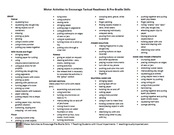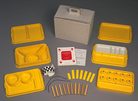- Home
-
Learn
- History of VI >
- Legislation & Laws >
- Vision Professionals >
-
VI Program Resources
>
- Program Printables
- Itinerant Teaching Tips
- Year at a Glance
- VI Program Handbook
- Caseload Analysis
- Organization & Time Management
- Professional Development
- Teacher Standards
- Professional Ethics
- Awards & Recognition
- APH Scholar Program
- Professional Organizations
- Certification Organizations
- Dealing with Challenges
- Professional Publications >
- Relatable Books for All Ages >
- Family Resources >
- Plan
- Basics
-
Teach
- Teaching Strategies >
-
Compensatory Skills Instruction
>
-
Social Skills
>
-
Self Determination
>
- Body Image & Acceptance
- Making Personal Goals
- My Vision Presentation
- My Self-Description
- Create a Personal Data Sheet
- Disclosure Decision
- Disability Statement
- Requesting Help
- Fighting Fears
- My Circle of Support
- Personal Responsibility
- Advocate for Safe Enviroments
- Having Picture Taken
- Coping with Change
- Aging Eyes
- Physical Characteristics
- Political Activism
- Laws Regarding Persons with Disabilities
-
Sensory Efficiency
>
-
Independent Living
>
- Orientation & Mobility Instruction >
- Recreation & Leisure >
-
Career & Vocation
>
-
Grow
- Complete Set Bonus >
-
Recorded Presentations
>
- Webinar: Tips for Being a "Physically Fit" TVI
- Webinar: The Art of Teaching the ECC
- Webinar: Virtual & F2F Strategies
- Webinar: Foundations of Teaching the ECC in the Age of Virtual Instruction
- Webinar: Itinerant Teaching Strategies
- Webinar: Using Themes to Teach the ECC
- Webinar: Conducting a FVLMA
- Webinar: Selecting the Right AT
- Webinar: Developing SMARTER Goals
- Webinar: Determining Service Intensity Using the VISSIT
- Webinar: Activities to Teach the ECC
- Webinar: Accessible Content for BLVI
- Webinar: Accommodations for VI
- Webinar: MIMO Strategies & Activities
- Webinar: SIDPID Strategies & Activities
- Webinar: Standard Course of Study Strategies & Activities
- Webinar: Job Tasks for Job, Career & Life
- Shop
- Jobs
Developing Skillful HandsBy: Carmen Willings
teachingvisuallyimpaired.com Updated June 9, 2019 All students need to develop strength and dexterity to complete everyday tasks. This is especially important for future braille learners in order to be able to use the braillewriter and slate and stylus. Remember the Occupational Therapist can be a great resource for activities to develop these skills. The Texas School for the Blind and Visually Impaired (TSBVI) has a great list of motor activities to encourage pre-braille skills. Importance of Fine Motor SkillsThe development of fine motor skills is important for all students to develop, but is especially important for students who are visually impaired and blind as they rely on their hands to learn about their world. Fine motor skills include palmar grasp, grasp with thumb and fingers, pincer grasp, release, rotary motion, finger isolation, bilateral hand use, hand and finger strength, proper finger position, light touch, and tactual tracking skills. It is important to play with and manipulate a variety of toys and materials that are tactually interesting and to talk to the student about what they are feeling. Fine motor skills become refined through practice and participating in activities that require manipulation of hands and fingers. Learn more about the development of fine motor skills on the Developing Skillful Hands page of this website.
Finger Strength & GripDeveloping finger strength and grip are important skills for all students, particularly for students who will be braille readers/writers. The following are age-neutral activities to help develop finger strength and grip.
Manipulate ObjectsOnce students begin exploring objects, encourage them to begin to manipulate the objects by banging, shaking, squeezing, poking, pushing, pulling, and moving various parts. Provide a variety of shaped and sized containers for the students to explore. Place toys/objects inside and encourage the student to reach in and pull them out as well as put them back in. Give the student objects that can be put together and pulled apart. Provide toys and objects that are wrapped and have the students unwrap them. Encourage the students to use two hands in an organized manner to manipulate objects (e.g., grasp/release, twist/turn, rotate and examine, open/close, stack, nest). Demonstrate how to perform different actions with the objects to help expand their play skills.
Tasks to Develop Skillful HandsDeveloping skillful hands is important skills for all students, especially for students who will be braille readers/writers. The following are age-neutral activities to help develop finger strength and grip. Students can also explore items to take apart and examine such as old toasters, flashlights or radios.
Additional Resources
Motor Activities to Develop Pre-Braille Skills
You are welcome to print and use this list of motor activities that can help develop tactual skills and pre-braille skills. 
Hands On Kit: Functional Activities for Visually Impaired Preschoolers This kit, available from APH, provides suggestions on helping children develop skills such as concentration and hand and visual coordination. The work-play trays help define the work space.
|
ECC InstructionTeaching Strategies
Compensatory Skills
Concept Development
Alternative Communication
Emergent Literacy
Access Print
Access Environmental Print Pre-Braille
Braille Code
Braille Formatting BraillewriterSlate & StylusTactile Graphics
Assistive Technology
VI AT Printables Basic UseProblem Solve Braille NotetakeriOS/Tablet
Windows KeystrokesWord ProcessingProductive Online VI AT Resources Social Skills
Social Skill Needs Non-Verbal Skills
Self Determination
Self Determination Skills
Sensory Efficiency
Sensory Input Sensory Areas & RoomsAuditory ReadinessVisual Efficiency Skills
Independent Living
Personal Care
Hygiene & Grooming
Shopping & Consumerism
Orientation & Mobility
Recreation & Leisure
Career & Vocational
Job Awareness
|
|
Teaching Students with Visual Impairments LLC
All Rights Reserved |
- Home
-
Learn
- History of VI >
- Legislation & Laws >
- Vision Professionals >
-
VI Program Resources
>
- Program Printables
- Itinerant Teaching Tips
- Year at a Glance
- VI Program Handbook
- Caseload Analysis
- Organization & Time Management
- Professional Development
- Teacher Standards
- Professional Ethics
- Awards & Recognition
- APH Scholar Program
- Professional Organizations
- Certification Organizations
- Dealing with Challenges
- Professional Publications >
- Relatable Books for All Ages >
- Family Resources >
- Plan
- Basics
-
Teach
- Teaching Strategies >
-
Compensatory Skills Instruction
>
-
Social Skills
>
-
Self Determination
>
- Body Image & Acceptance
- Making Personal Goals
- My Vision Presentation
- My Self-Description
- Create a Personal Data Sheet
- Disclosure Decision
- Disability Statement
- Requesting Help
- Fighting Fears
- My Circle of Support
- Personal Responsibility
- Advocate for Safe Enviroments
- Having Picture Taken
- Coping with Change
- Aging Eyes
- Physical Characteristics
- Political Activism
- Laws Regarding Persons with Disabilities
-
Sensory Efficiency
>
-
Independent Living
>
- Orientation & Mobility Instruction >
- Recreation & Leisure >
-
Career & Vocation
>
-
Grow
- Complete Set Bonus >
-
Recorded Presentations
>
- Webinar: Tips for Being a "Physically Fit" TVI
- Webinar: The Art of Teaching the ECC
- Webinar: Virtual & F2F Strategies
- Webinar: Foundations of Teaching the ECC in the Age of Virtual Instruction
- Webinar: Itinerant Teaching Strategies
- Webinar: Using Themes to Teach the ECC
- Webinar: Conducting a FVLMA
- Webinar: Selecting the Right AT
- Webinar: Developing SMARTER Goals
- Webinar: Determining Service Intensity Using the VISSIT
- Webinar: Activities to Teach the ECC
- Webinar: Accessible Content for BLVI
- Webinar: Accommodations for VI
- Webinar: MIMO Strategies & Activities
- Webinar: SIDPID Strategies & Activities
- Webinar: Standard Course of Study Strategies & Activities
- Webinar: Job Tasks for Job, Career & Life
- Shop
- Jobs

